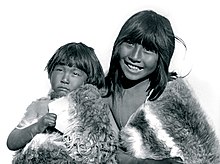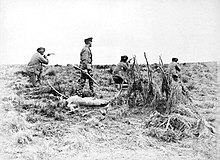
Tierra del Fuego is an archipelago off the southernmost tip of the South American mainland, across the Strait of Magellan.

Tierra del Fuego, officially the Province of Tierra del Fuego, Antarctica and South Atlantic Islands, is the southernmost, smallest, and least populous Argentine province. The provincial capital city is Ushuaia, from a native word meaning "bay towards the end".

The Chonan languages are a family of indigenous American languages which were spoken in Tierra del Fuego and Patagonia. Two Chon languages are well attested: Selk'nam, spoken by the people of the same name who occupied territory in the northeast of Tierra del Fuego; and Tehuelche spoken by the people of the same name who occupied territory north of Tierra del Fuego. The name 'Chon', or Tshon, is a blend of 'Tehuelche' and 'Ona'.

The Yahgan are a group of indigenous peoples in the Southern Cone of South America. Their traditional territory includes the islands south of Isla Grande de Tierra del Fuego, extending their presence into Cape Horn, making them the world's southernmost human population.
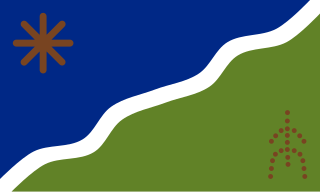
The Kawésqar, also known as the Kaweskar, Alacaluf, Alacalufe or Halakwulup, are an indigenous people who live in Chilean Patagonia, specifically in the Brunswick Peninsula, and Wellington, Santa Inés, and Desolación islands northwest of the Strait of Magellan and south of the Gulf of Penas. Their traditional language is known as Kawésqar; it is endangered as few native speakers survive.

Anne MacKaye Chapman was a Franco-American ethnologist who focused on the people of Mesoamerica writing several books, co-producing movies, and capturing sound recordings of rare languages from the Northern Triangle of Central America to Cape Horn in South America.

Dawson Island is an island in the Strait of Magellan that forms part of the Tierra del Fuego archipelago, 100 km south of the city of Punta Arenas in Chile, and part of the Municipality of Punta Arenas. It is located southeast of Brunswick Peninsula. It is often lashed with harsh Antarctic weather. The settlements are Puerto Harris, Puerto San Antonio and Puerto Almeida.
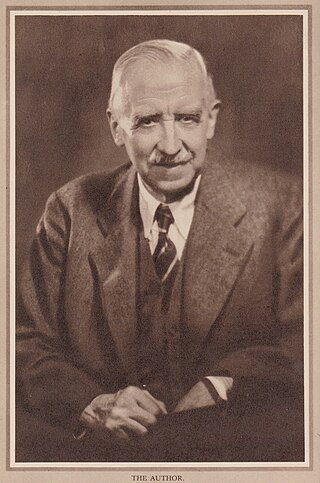
Esteban Lucas Bridges was an Anglo-Argentine author, explorer, and rancher. After fighting for the British during the First World War, he married and moved with his wife to South Africa, where they developed a ranch with her brother.
Ona, also known as Selk'nam (Shelknam), is a language spoken by the Selk'nam people in Isla Grande de Tierra del Fuego in southernmost South America.

Fuegians are the indigenous inhabitants of Tierra del Fuego, at the southern tip of South America. The name has been credited to Captain James Weddell, who supposedly created the term in 1822.

Ángela Loij López, baptized as Ángela Gómez, was an Argentine-Chilean woman considered to be the last surviving individual of full-blooded Selk'nam (Ona) descent, an indigenous group that resided in Tierra del Fuego.
The Fuegian languages are the indigenous languages historically spoken in Tierra del Fuego by Native Americans. Adelaar lists the Fuegian languages as the Kawésqar language, the Ona language and the Yaghan language in addition to Chono, Gününa Yajich, and the Tehuelche language.
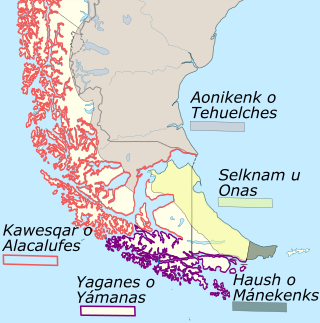
The Haush or Manek'enk were an Indigenous people who lived on the Mitre Peninsula of the Isla Grande de Tierra del Fuego. They were related culturally and linguistically to the Selk'nam people who also lived on the Isla Grande de Tierra del Fuego, and to the Tehuelche people of southern mainland Patagonia.
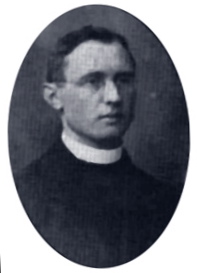
Martín Gusinde was an Austrian priest and ethnologist famous for his work in anthropology, particularly on the native groups of Tierra del Fuego. He was one of the most notable anthropologists in Chile in the first half of the 20th century, together with Max Uhle and Aureliano Oyarzún Navarro.
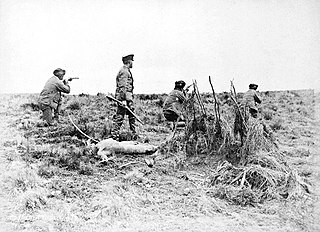
The Selk'nam genocide was the systematic extermination of the Selk'nam people, one of the four indigenous peoples of Tierra del Fuego, in the late 19th and early 20th centuries. Historians estimate that the genocide spanned a period of between ten and twenty years, and resulted in the decline of the Selk'nam population from approximately 4,000 people during the 1880s to a few hundred by the early 1900s.

The Martin Gusinde Anthropological Museum is an anthropology museum in Puerto Williams, Isla Navarino, in southern Chile. It is the southernmost museum of the world. The museum hosts artifacts, maps and photographs related to the 10,000-year history of the Yahgan people, as well as European settlers since the 19th century. Samples of local flora and fauna are also displayed, as well as photographs and text from the founding of Puerto Williams.

Thomas Bridges was an Anglican missionary and linguist, the first to set up a successful mission to the indigenous peoples in Tierra del Fuego, an archipelago shared by Argentina and Chile. Adopted and raised in England by George Pakenham Despard, he accompanied his father to Chile with the Patagonian Missionary Society. After an attack by indigenous people, in 1869 Bridges' father, Despard, left the mission at Keppel Island of the Falkland Islands, to return with his family to England. At the age of 17, Bridges stayed with the mission as its new superintendent. In the late 1860s, he worked to set up a mission at what is now the town of Ushuaia along the southern shore of Tierra del Fuego Island.

The Sociedad Explotadora de Tierra del Fuego was a historically important company operating within the Chilean and Argentine region of Patagonia. It was founded in 1893 and cultivated over 1,000,000 ha land for sheep farming and private factories like Puerto Bories to process, freeze and export sheep meat.

The Fuegian dog, or Yahgan dog, or Patagonian dog, is an extinct type of canid. In comparison to the domestic dog's ancient wolf ancestry, the Fuegian dog was traditionally thought to be bred and domesticated from the South American culpeo, also known as the culpeo fox. However, 2023 research suggested that the traditional accounts of the Fuegian dog were in fact two different animals. The culpeo itself is similar to true foxes, though it is closer, genetically, to wolves, coyotes and jackals ; thus it is placed in a separate genus within the South American foxes or zorros.
Selk'nam mythology is the body of myths of the Selk'nam and Haush peoples of Tierra del Fuego.
